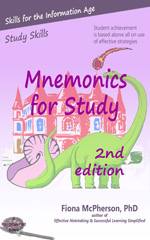What mnemonics are, and what they are for
Aids to memory such as acronyms, rhymes, linking information by creating visual images or making up a story, are called mnemonics. Mnemonic strategies have been recommended as appropriate for remembering the following types of information:
- shopping lists
- vocabulary
- appointments
- speeches
- facts
- names & faces
- dates
- phone numbers
- ideas
- jokes
- dramatic parts
- poems
- numbers
Mnemonics are undoubtedly effective for rote memorization, but they do require a lot of work to master.
Mnemonics can also help you learn basic facts and new vocabulary, which you need to acquire when learning a new subject. However, mastering a subject is not simply a matter of knowing a lot. An expert has a well-organized network of memory codes into which new information can be easily integrated. Mnemonic techniques on their own do not help you understand the meaning of facts, and do not therefore help you develop expertise in a subject.
Moreover, although mnemonics are usually the best strategies for memorizing by rote, for most tasks there are easier strategies which are sufficiently effective to be preferable for many people:
- written or electronic records
- rote repetition
The value of lists
For many tasks and for most people, a written list is far less effort, far more likely to be used, and far more reliable.
Many people discard the idea of lists because they have found they usually forget to use them. However, research has confirmed what many of us already know from experience — even if you forget to refer to your list, you are much more likely to recall items that you have written down. The act of writing (and perhaps the opportunity to visualize your list) are sufficient to improve your memory.
Imagery in mnemonics
Visual imagery underlies most mnemonic strategies. The best known are the list-learning strategies — the method of loci, the pegword method, and the link method. While these are undoubtedly effective strategies, they perhaps have less value as general strategic tools than the transformational elaborative strategies — the keyword method, and face-name association.
The role of imagery in helping memory is largely misunderstood (see the myth of imagery). Methods that use words rather than images have been shown to be equally effective. Imagery has one major advantage, and that is the ease with which two items can be connected using imagery. Imagery also has one major disadvantage, and that is the difficulty many people have with creating images.
Verbal mnemonic strategies include the use of acronyms, rhymes, and the more complex coding method (for memorizing numbers) and the story method (the verbal equivalent of the linking mnemonic).
When it’s best to use a mnemonic
- when information only need to be remembered for a short time
- as a reminder for well-learned information (to help overcome memory blocks; to remind you of the order of information)
- when written records are impossible, inconvenient, or inappropriate
- to anchor facts
When it’s best to write something down
- when you need to remember the information for a long time
- when reliability and accuracy are important
- when memory load is to be avoided
- when information is coming at you too fast
- when the information is too complex
- Belleza, F.S. 1983. Mnemonic-device instruction with adults. In Pressley, M. & Levin, J.R. (eds.) Cognitive strategy research: Psychological foundations. New York: Springer-Verlag.
- Bransford, J.D., Stein, B.S., Vye, N.J., Franks, J.J., Auble, P.M., Mezynski, K.J. & Perfetto, G.A. 1982. Differences in approaches to learning: an overview. Journal of Experimental Psychology: General, 111, 390-398.
- Intons-Peterson, M.J. & Newsome, G.L. III. 1992. External memory aids: effects and effectiveness. In D. Herrmann, H. Weingartner, A. Searleman & C. McEvoy (eds.) Memory Improvement: Implications for Memory Theory. New York: Springer-Verlag.
